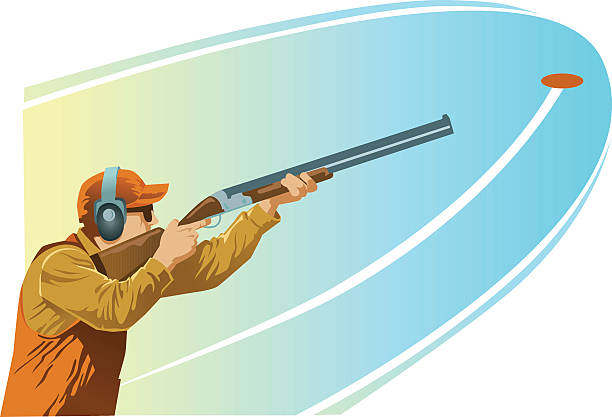Clay Shooting and its benefits
- Gavin Fitzhugh

- May 28
- 3 min read
Trap Shooting vs. Skeet Shooting: Practical Benefits for Hunters
Trap shooting and skeet shooting are two of the most popular shotgun sports, often misunderstood by novices but distinct in their rules, configurations, and target trajectories. Although both involve shooting at clay targets (commonly referred to as clay pigeons) launched into the air, their similarities largely end there. Understanding these differences—and training in both disciplines—can significantly enhance your success in the field. These sports not only refine shooting mechanics but also replicate scenarios hunters encounter in real life, from rapid reflex shots to precise tracking.

Skill Development Through Clay Shooting
Before entering the field, clay shooting assists you in:
Becoming accustomed to your firearm and developing familiarity with its feel. Consistent practice ensures your firearm becomes second nature, enhancing reaction times and minimizing fumbling in the field.
Practicing natural movements and improving overall shooting form. Whether you shouldering the shotgun or following through with your swing, good form enhances accuracy.
Refining your cheek placement for consistent sight alignment. A proper cheek weld improves your sight picture and shot placement.
Enhancing your ability to swing, track, and lead moving targets. The skill to “read” a target’s speed and angle directly translates to flying or fleeing game.
Understanding how your gun patterns and where it shoots. Patterning assists hunters in selecting the appropriate choke and load combination for specific hunting scenarios.
All these elements contribute to improved real-world outcomes during a hunt. Clay shooting also offers a low-pressure environment for safe and repetitive practice, building confidence and honing instincts.
Skeet Shooting: Precision for Passing Shots
Skeet shooting is designed around predictable crossing targets, where clays fly from high and low houses along fixed trajectories. This setup allows shooters to concentrate on rhythm, timing, and swing technique.
Skeet shooting closely resembles:
Duck and goose hunting, particularly when birds fly by a blind before landing or pass overhead.
Dove and pigeon shooting where birds dart quickly and erratically across the open sky.
Fast, short-distance shooting, requiring split-second decisions and target acquisition.
By mastering skeet, hunters become more adept at leading targets, keeping both eyes open for improved peripheral tracking, and maintaining smooth, controlled follow-through. These skills are crucial when waterfowl or upland birds unexpectedly zip past.
Trap Shooting: Adapting to Unpredictability
Trap shooting introduces more variability in target direction, speed, and height, better simulating the unpredictability of live field conditions. Targets fly away from the shooter at varying angles, enhancing both reflexes and adaptability.
Trap shooting prepares you for:
Upland bird hunting, where pheasants, quail, or grouse burst from cover in any direction.
Rabbit hunting, where sudden dashes across uneven terrain demand quick, accurate snap-shooting.
Fast-paced flushing scenarios, often granting hunters only seconds to shoulder their gun and fire.
Because trap emphasizes reaction time and target acquisition from unpredictable angles, it’s ideal for training under pressure and simulating adrenaline-filled hunting situations.
Sporting Clays: A Third Option for Realism
While trap and skeet provide excellent fundamentals, sporting clays—often referred to as “golf with a shotgun”—introduce even greater variety. With targets launched from various locations and simulating different types of game (rabbits, ducks, woodcock, etc.), this discipline combines the best of both worlds and mimics actual hunting terrain and unpredictability. For hunters seeking the most realistic clay shooting experience, sporting clays offer exceptional cross-training.

Additional Benefits for Hunters
Offseason Preparation: When hunting seasons are closed, clay shooting keeps skills sharp year-round and offers a fun, social way to stay engaged with shooting sports. Improved Gun Fit and Equipment Familiarity: Regular practice helps hunters make better-informed choices on gear, such as stock length, chokes, and ammunition, for their specific hunting style. Mental Focus and Shot Discipline: Knowing when not to shoot is as important as pulling the trigger. Clay shooting builds mental clarity, helping you avoid rushed or unsafe shots in the field. Stamina and Muscle Memory: Repeated shoulder mounts, swings, and target tracking build muscle memory and stamina, which assist during long days in the field or blinds.

Conclusion
Whether you are a novice or preparing for an upcoming hunting excursion, practicing trap and skeet shooting is an excellent way to enhance your proficiency and confidence with your firearm under pressure. The skill of tracking, timing, and hitting a moving target transcends sport, serving as a crucial survival ability in the wild. Engaging in clay shooting, whether as an enjoyable offseason activity or as part of a rigorous training program, will improve your adaptability and effectiveness as a hunter. You will develop sharper reflexes, increased confidence, and the practical skills essential for success when it truly matters.


.png)



Comments